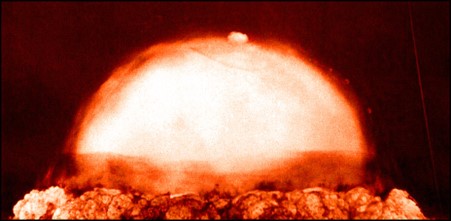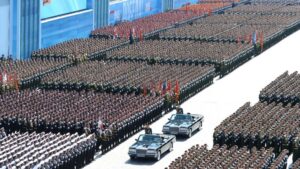Yes, Iran Has Probably Already Built The Bomb
I bet that got your attention. A more accurate statement is, “I think Iran has already built the bomb.” I do not say that lightly. The purpose of this article is to show you why I think that, why it is logical to think that, and why responsible leaders should be considering that probability when formulating policy (they are not).
There are two types of nuclear fission bomb design: gun type and implosion type. In 1945, the Manhattan Project produced both. Modern designs are almost invariably the implosion-type because of higher yield and advances in miniaturization. That does not make the gun type design any less viable.
The debate around Iran’s nuclear program has been based on the assumption that Iran is preparing to build an implosion-type device. Why not? That’s what everybody else is building. This is usually built with a Plutonium fissile core, but can be built from a Uranium core. Iraq was working on an implosion bomb based on a Uranium core.
Implosion bombs are more difficult to build and require testing to make sure they work properly. Gun-type bombs are straightforward to build and simple, so they don’t need to be tested (more about that later). They are built around Uranium, not Plutonium. And that’s what Iran’s been enriching.
So if you were Iran and had a nuclear-armed existential adversary staring at you over the sights of his Jericho missiles, would you lollygag building an implosion device? Or would you build a gun type bomb quick and dirty and slap it on an IRBM, good to go?
I know what I’d do.
Two Designs: Fat Man & Little Boy
The Manhattan Project built a gun type bomb and an implosion bomb. The gun type bomb was very simple. It involved putting two pieces of Uranium-235 at either end of a gun barrel and firing an explosive to slam them together like you clap your hands. That clap produced a critical mass that started a chain reaction of neutrons and a nuclear explosion. Figure 1 is Little Boy, the bomb they dropped on Hiroshima. It had a blast yield equivalent to 15 kilotons, or 15 thousand tons of TNT.
Figure 1. Gun-Type Atomic Bomb (Little Boy)
A gun-type bomb will fit in the warhead of one of Iran’s IRBMs. On October 1, they clearly demonstrated their ability to penetrate Israel’s air defense shield (see Iran Missile Attack Overwhelms Israeli Air Defenses). All Iran has to do is sneak one or two A-Bombs into a 50-IRBM salvo targeted at Tel Aviv, and it’s all over but the crying.
The implosion bomb is much more complicated. It involves setting a spherical core of Plutonium at the center of an explosive ball. Shaped charges are arranged around the core in a spherical array of explosive lenses. When the time comes to detonate the bomb, the explosions compress the sphere into a critical mass. The critical mass starts the chain reaction and a nuclear blast results. Figure 2 shows the implosion device, Fat Man. It had a blast yield of about 20 kilotons, and they dropped it on Nagasaki.
Figure 2. Implosion-Type Atomic Bomb (Fat Man)
Gun-Type Bomb (Little Boy)
Let’s take a look at the designs in a little more detail.
Figure 3. Gun-Type Atomic Bomb, cutaway view.
Not much to say about Figure 3. It’s self-explanatory. You have two pieces of Uranium at either end of a gun barrel. You fire an explosive and slap them together. Little Boy was designed by a couple of physicists, a couple of engineers, and a naval ordnance specialist on the back of a napkin. Then, they put it away and set about working on the implosion device while waiting for the uranium to be enriched. Sound familiar? That’s what the Iranians have been doing for years.
Implosion Bomb (Fat Man)
The implosion bomb is far more complicated and interesting. That’s why science guys nerd out on it. It’s a beach ball of explosives with a fissile core of Plutonium at the center. Now, it could be a Uranium core, too. That changes the calculations, and it changes the production process. Producing Plutonium is a different process than producing enriched Uranium. We won’t talk about that much here. Suffice to say, the Iranians seem to be going the enriched Uranium route. They have the “breeder reactors” to produce Plutonium, but they seem to be relying on Uranium enrichment cascades.
Figure 4 shows the Fat Man implosion device that fits into the bomb in Figure 2.
Figure 4. Implosion-Type Bomb (Fat Man)
Why is the implosion device more complicated than the gun-type device? It has to do with the explosive lenses. The explosive lenses are shaped charges that create a uniform spherical shock wave that perfectly compresses the fissile core into a critical mass.
The explosives all have to go off at the same time. To do this, they have to be detonated by extremely high-speed electrical switches called Krytrons. All those wires attached to the sphere are there to make the explosives go off simultaneously. Figure 5 shows the internals of the Iraqi bomb.
Figure 5. Implosion-Type Bomb (Iraqi Device)
The fissile core is in the middle. The pear slices are the explosive lenses. The heavy black line is labeled “firing set.” This amounts to the battery, the timer or trigger device, and the switches. The Krytrons, to make all the lenses go off at the same time.
Note that Krytrons are hard to get. They are specialty products subject to strict export controls, and no manufacturer can legally sell them to Iran.
Let’s say Iran got its hands on some Krytrons and built that device. It is very delicate. They have to test it to make sure the explosives create a perfect spherical shock wave and detonate the bomb. If they don’t, you get a shock wave that looks like a pear or a peanut shell. You get a “fizzle” or a “partial detonation.” That’s why everybody assumes a country has to conduct tests before it “breaks out” and goes nuclear.
You know what happens when people assume things, right?
How Much Enriched Uranium-235 Does Iran Have?
In July, 2024, CNN reported that Tony Blinken warned that Iran was two weeks away from having enough fissile material to build a bomb: CNN: Blinken Says Iran’s Nuclear Weapon Breakout Time is Down to 1-2 Weeks. In the same article, the writers stated: “Over a year ago a top US Defense Department official said that Iran could now produce ‘one bomb’s worth of fissile material’ in “about 12 days.”
That article was written over two months ago, and their anonymous Defense Department official made his 12-day call over a year and two months ago.
That’s a non-sequitur if I ever saw one.
I don’t know about you, but I assume they’ve got enough for at least one. Probably more. And have had it available for a very long time.
Testing (or all those darn earthquakes)
India tested their bomb. So did Pakistan, North Korea, Israel and South Africa (the infamous “Vela Joint Nuclear Test Incident”). Of course, Iran has to test their bomb too. That’s why scientists and intelligence agencies are monitoring radiation levels and studying seismograph tracings. Every earthquake anywhere near Iran is scrutinized on the chance it could be a nuclear test.
We just explained why you have to test an implosion device.
Here’s the news: you don’t have to test a gun-type device. The device is so simple, the Manhattan Project determined that they didn’t need to test it. They knew it would work.
One Hundred Thousand KIA
Israel is a small country. It’s shaped like an hourglass with a fat bottom, fat top, and narrow waist. Its population is concentrated in its major cities. Any attack on Tel Aviv or Haifa will cause massive casualties.
The Little Boy bomb had a yield of 15 kilotons. Alex Wellerstein has created an interactive map that war games what would happen if nuclear devices of various yields were dropped on different cities. You can access it here, and play what-if:
Just for s**ts and giggles, select Tel Aviv and type in a yield of 15 kilotons. Israel’s population is so concentrated, a burst the size of the Hiroshima bomb would kill 98,000 people outright and injure almost a quarter of a million more. Figure 6 shows the effect.
Figure 6. Projected Effect of 15-Kiloton Blast on Tel Avi
Conclusions
To reiterate, Iran does not need to test a gun-type nuclear bomb. All the non-nuclear components are easily manufactured and assembled. All the bomb needs is the enriched Uranium-235. The detonator can be anything. A contact fuse, a radar altimeter, a barometric pressure switch. Disarmed on launch, armed above a certain altitude on the way up, fires when it passes a certain altitude, say a thousand feet, on the way down (select “airburst” in the Nukemap app). Whatever. As David Niven said in The Guns of Navarone, “It’s not hard to detonate explosives, sir. The trick is to not be around when they go off.”
Is Iran supposed to sit on its hands while Israel points nuclear-tipped Jericho missiles at it? Of course not.
Russia could give Iran a bomb. So could North Korea. Or China.
Or… maybe Iran already has built a whole bunch.
I would.
—
Cameron Curtis can be reached at [email protected]
He is the author of the Breed action thriller series, available on Amazon. The stories are adrenaline-fuelled and emotionally engaging. The novels combine credible premises based on current events, technical detail, and propulsive plotting.
Check out his new Breed thriller, BLOWBACK, here: BLOWBACK by Cameron Curtis available for download now at just $0.99 The story involves the theft of a thermonuclear bomb (H-Bomb) that includes a fission device like the ones described in this article.
**Editor’s Note: If you haven’t picked up your copy yet, what are you waiting for? Breed for a buck, it’s a no brainer. — GDM



